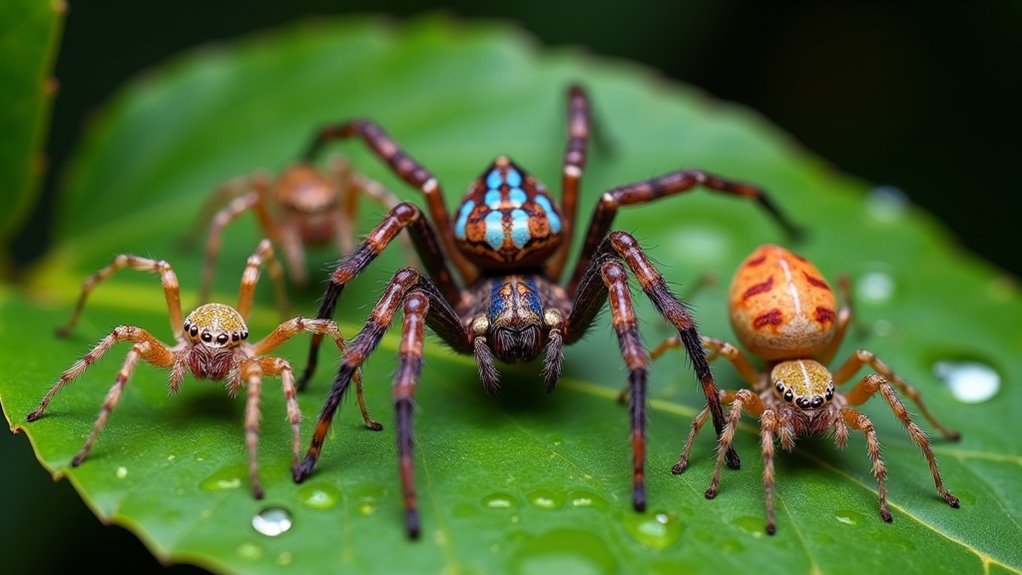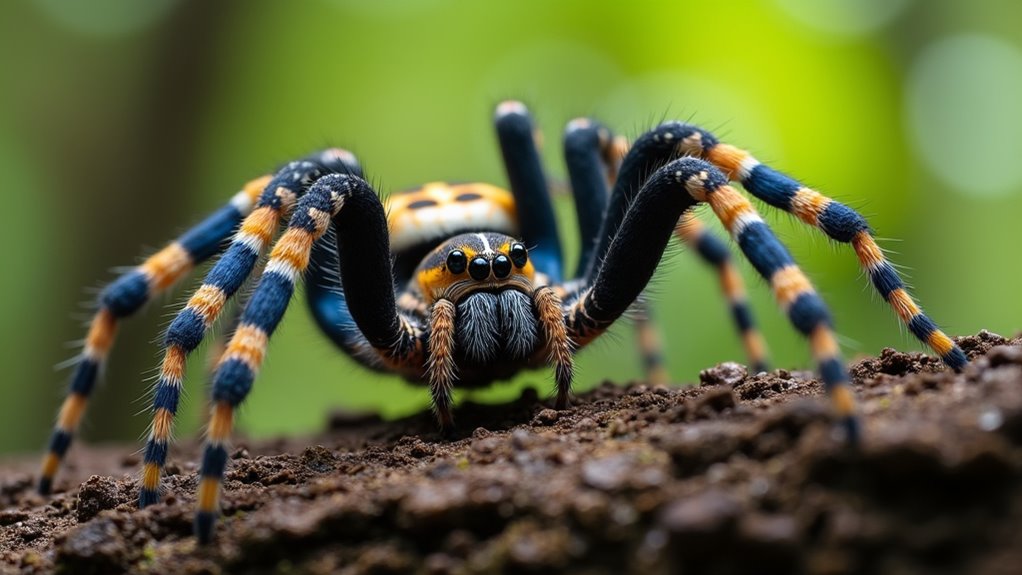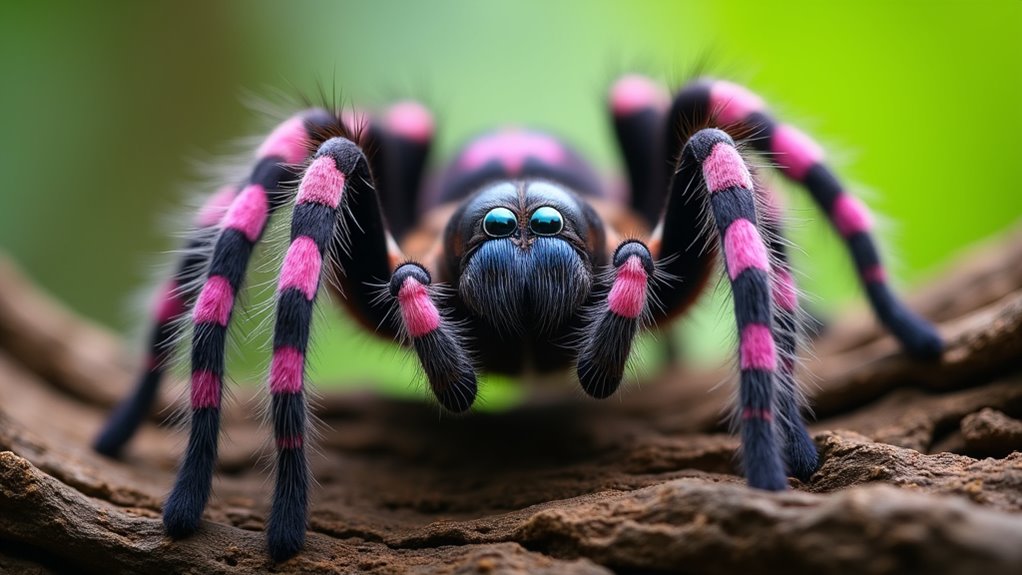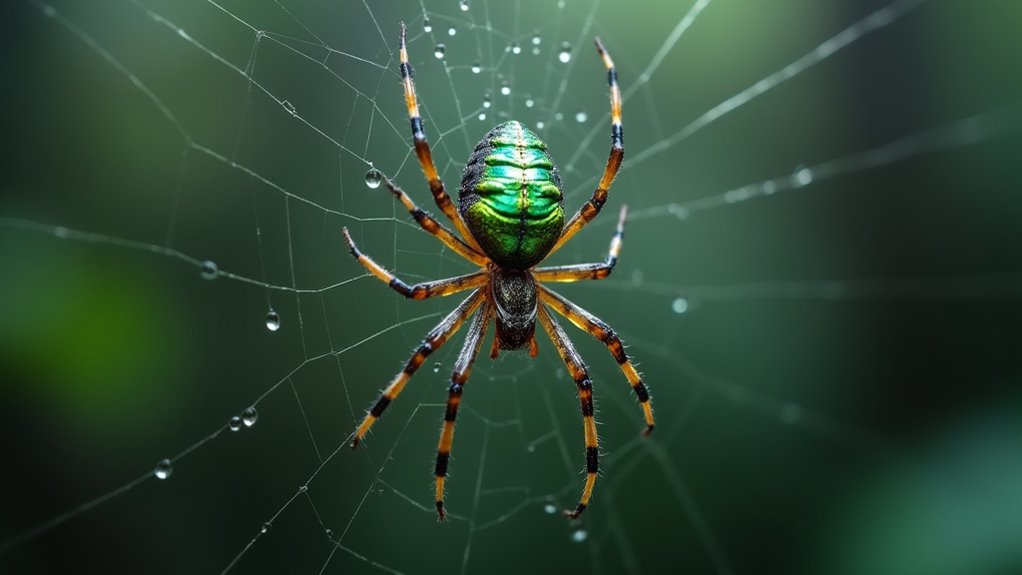Physical Address
304 North Cardinal St.
Dorchester Center, MA 02124
Physical Address
304 North Cardinal St.
Dorchester Center, MA 02124

In Sri Lanka's wild habitats lurk five extraordinary spider species with unique abilities, striking colors, and fascinating survival techniques.
Sri Lanka hosts remarkable spiders worth knowing: the endangered Ornamental Tiger Spider with striking spotted patterns; Golden Orb Weavers creating massive yellow silk webs; the recently discovered Rajaei’s Tarantula with its impressive 8-inch leg span; the master-of-disguise Ornamental Tree Trunk Spider; and the pear-shaped Opadometa Fastigata with its vivid orange-black coloration. Each species faces unique threats while playing vital roles in their ecosystems. Discover how these fascinating arachnids survive in Sri Lanka’s diverse habitats.

While many travelers visit Sri Lanka for its beaches and elephants, they often overlook one of the island’s most magnificent creatures—the Ornamental Tiger Spider (Poecilotheria ornata). This large arachnid, also known as the fringed ornamental, makes its home in the island’s tropical forests.
You’ll find these impressive spiders living in tree cavities and under bark, where they create silken retreats for protection. They’re skilled climbers with distinctive markings that help them blend into their arboreal environment. Their name derives from Greek word origins that highlight their beautiful spotted patterns.
Unfortunately, these spiders face serious threats from deforestation, habitat destruction, and collection for the pet trade. Conservation efforts focus on establishing protected areas and implementing legal protections to save these creatures.
If you’re exploring Sri Lanka’s forests, respect their habitat—these spiders can be aggressive when threatened.
Another arachnid marvel in Sri Lanka’s forests is the Golden Orb Weaver (Nephila pilipes). You’ll spot these spiders by their striking size difference—females grow to 30-50mm with silvery-grey to plum bodies, while males remain tiny at just 5-6mm.
Their impressive vertical webs span up to 5 feet, glistening with characteristic yellow silk that gives them their name. These aren’t ordinary webs—they feature elastic centers specifically designed to trap fast-moving insects. The webs are remarkably strong and can occasionally trap small birds or bats that the spider then wraps and feeds on.
You’ll find these spiders in Sri Lanka’s moist, shaded rainforests, often near water sources. Despite their imposing appearance, you needn’t worry about bites, which are extremely rare. Birds remain their primary predators, though the spiders cleverly construct aggregated web systems for protection.

In 2009, scientists identified one of Sri Lanka’s most remarkable endemic spiders, Poecilotheria rajaei, after a villager delivered a dead specimen to local researchers. This impressive tarantula, with its 8-inch leg span and distinctive pink abdominal band, quickly captured international attention.
You’ll find this tree-dwelling giant exclusively in northern Sri Lanka, where it inhabits old trees with natural hollows and bark crevices. The species is particularly noteworthy for its beautiful subtle color markings of gray, pink, and daffodil yellow.
Unfortunately, deforestation has forced many specimens into human structures, including village hospitals and homes.
Despite its intimidating size, Raja’s tiger spider isn’t lethal to humans, though it can capture prey as large as small birds and lizards.
Conservation efforts are critical as this species faces threats from habitat destruction, pesticide use, and fear-driven killings by locals who encounter them in their homes.
Among Sri Lanka’s remarkable arachnids, the Ornamental Tree Trunk Spider (Herennia multipuncta) is distinguished as a true master of disguise. You’ll find this spotted coin spider perfectly blended against tree trunks and building walls with its dappled reddish-brown and grey coloration. The species has been well-documented by nature enthusiasts through iNaturalist observations.
The female, measuring 10-14mm, creates a small orb web just millimeters above bark surfaces, while the much smaller male (5-7mm) maintains a similar cryptic appearance.
What makes this Nephilidae family member fascinating:
This camouflage expert helps control insect populations in both natural and urban environments.

While Sri Lanka’s tree trunk spiders blend into their surroundings, the pear-shaped Opadometa fastigata commands attention with its striking appearance. This member of the Tetragnathidae family showcases a distinctive orange and black coloration that’s impossible to miss in wooded areas.
You’ll notice its unique pear-shaped abdomen that distinctly overhangs the cephalothorax. Females measure 8-9mm, nearly triple the size of their 3mm male counterparts. The distinctive pear-shaped body is one of its most recognizable taxonomic features.
Look for the thick brush of spines on their fourth pair of legs—a telltale identification feature.
Their small orb webs are architectural marvels with open hubs and wide-set spirals, typically constructed near water bodies. These solitary hunters are most active during daylight hours.
Though primarily documented from India to the Philippines, you might spot these fascinating arachnids in Sri Lanka’s forested regions.
You’ve just explored five of Sri Lanka’s most remarkable spiders, but they represent only a fraction of the island’s arachnid diversity. With over 500 spider species documented in this biodiversity hotspot, scientists estimate that 60% are endemic, found nowhere else on Earth. As you venture outdoors, remember that these eight-legged architects play vital roles in controlling insect populations and maintaining the delicate balance of Sri Lanka’s ecosystems.